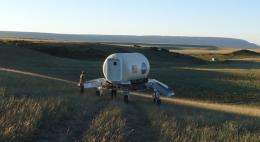NASA engineers test mobility and endurance of the ATHLETE rover on Mission Day 2 at NASA's Desert RATS. Image credit: NASA
(PhysOrg.com) -- The ATHLETE rover, currently under development at NASA's Jet Propulsion Laboratory, Pasadena, Calif., is in the Arizona desert this month to participate in NASA's Research and Technology Studies, also known as Desert RATS. The desert tests offer a chance for a NASA-led team of engineers, astronauts and scientists from across the country to test concepts for future missions.
NASA will demonstrate a variety of hardware during this year's test, including:
-- All-Terrain Hex-Legged Extra-Terrestrial Explorers (ATHLETE): two heavy-lift rover platforms that allow a habitat, or other large items, to go where the action is.
-- Space Exploration Vehicles: two rovers astronauts could live in for seven days at a time.
-- Habitat Demonstration Unit/Pressurized Excursion Module: a simulated habitat where the rovers can dock to allow the crew room to perform experiments or deal with medical issues.
-- Portable Communications Terminal: a rapidly deployable communications station.
-- Centaur 2: a four-wheeled possible transportation method for NASA Robonaut 2.
-- Portable Utility Pallets: mobile charging stations for equipment.
-- A suite of new geology sample collection tools, including a self-contained GeoLab glove box for conducting in-field analysis of various collected rock samples.
The public was involved in test preparation by helping NASA decide what areas should be explored. NASA posted several possibilities online and allowed members of the public to vote on the most promising locations. Several thousand ballots were cast and 67 percent favored a location that appeared to be home of several overlapping lava flows.
More information:
For more information about NASA's field tests and to follow Desert RATS on various social media sites, visit:
www.nasa.gov/exploration/analogs/desert_rats.html
Provided by JPL/NASA























